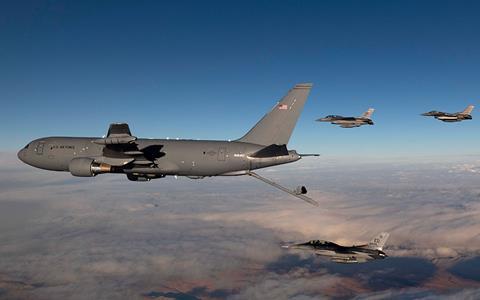By overlooking design changes made by Boeing to the KC-46A’s refuelling boom, the US Air Force (USAF) missed an opportunity to catch problems early and stave off a $100 million redesign effort.
The service also “did not ensure that critical technologies for the tanker’s refuelling boom were demonstrated in a relevant testing environment” the Department of Defense’s Inspector General says in a report released on 21 May.

The Inspector General’s report adds more detail to problems that continue to dog the KC-46A programme. Many of those problems, including problems with the tanker’s refuelling boom, came from immature technology that wasn’t sufficiently tested prior to the aircraft starting production.
The KC-46A’s refuelling boom is too stiff and thus not able to extend or retract while in contact with an aircraft receiving fuel, says the Inspector General. As a result, recipient aircraft pilots have to make large engine power corrections, to adjust their aircraft’s position forward or backward to maintain contact with the refuelling boom.
“The large engine power corrections could result in potentially unsafe flight operations during the process of disconnecting the receiver aircraft from the refueling boom,” says the Inspector General’s report. “Because the refueling boom was too stiff, it caused pilots of receiver aircraft to inadvertently use excess engine power or not use enough engine power, which, upon disconnecting from the refueling boom, could cause the receiver aircraft to rapidly accelerate toward or away from the tanker.”
By using aircraft throttle to maintain contact with the refuelling boom, pilots could accidentally lunge forward into the boom, causing damage, the report adds.
As a result, the KC-46A tanker could not refuel the Fairchild Republic A-10 close-air support aircraft or several variants of the Lockheed Martin C-130 transport. The USAF has said that the A-10 lacks the thrust necessary to push into the boom.
Furthermore, the USAF imposed operational limitations on many of its other aircraft, allowing the Boeing B-52, Boeing C-17, Boeing F-15, Lockheed Martin F-16, Lockheed Martin F-35A, Lockheed Martin HC/MC-130J, McDonnell Douglas KC-10, Boeing KC-46A, and Boeing KC-135 receiver to refuel in limited conditions only. For example, aircraft are allowed to refuel when the boom’s range of motion is reduced. And, aircraft are forbidden from refuelling in covert or lights-out scenarios.
Initially, the KC-46A tanker refuelling boom design was based on the KC-10’s refueling boom and its control laws were based on the control laws of the Italian KC-767A and Japanese KC-767J. Those technologies were deemed well-proven and thus it was thought further review wasn’t needed.
However, during the preliminary design review in 2012 Boeing presented a new boom design that “differed significantly”, the Inspector General says. The KC-46A’s new boom was computer controlled versus the hydromechanically controlled boom on the KC-10. The KC-46A’s boom was novel and should have been further reviewed, says the Inspector General’s report.
Ultimately, the design changes didn’t receive the review or testing necessary, the Inspector General says.
“Had KC-46 programme office officials effectively managed the development and testing of the refuelling boom for the KC-46A tanker, the Air Force would not have had to spend an additional $100 million for the redesign of the refuelling boom to achieve the required performance,” the report says.
Retrofit work is not likely to start until January 2024 and will cost the service even more, it adds.
“This delay limits the [Department of Defense’s] use of the KC-46A tanker for its intended refuelling missions,” says the Inspector General. “Additionally, the Commander of United States Transportation Command identified the aerial refuelling fleet as the most stressed of air mobility forces and stated that any delay of the KC-46 production puts the joint force’s ability to effectively execute war plans at risk.”































